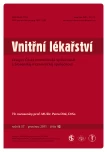Survival of patients after TIPS in the University Hospital Hradec Kralove
Authors:
Š. Šembera 1; V. Jirkovský 2; T. Fejfar 2; V. Šafka 2; O. Renc 3; J. Raupach 3; V. Chovanec 3; Miroslav Lojík 3; A. Krajina 3; P. Hůlek 2
Authors‘ workplace:
Lékařská fakulta UK Hradec Králové, děkan prof. MUDr. RNDr. Miroslav Červinka, CSc.
1; II. interní klinika Lékařské fakulty UK a FN Hradec Králové, přednosta prof. MUDr. Jaroslav Malý, CSc.
2; Radiologická klinika Lékařské fakulty UK a FN Hradec Králové, přednosta prof. MUDr. Pavel Eliáš, CSc.
3
Published in:
Vnitř Lék 2011; 57(12): 1038-1044
Category:
70th birthday of prof. MUDr. Petr Dítě, DrSc.
Overview
Aim:
To analyze survival of patients after TIPS (transjugular intrahepatic portosystemic shunt).
Patient sample and methodology:
Between September 1992 and August 2010, TIPS was created in 848 patients of the University Hospital Hradec Kralove. These patients were divided into groups. Survival was analyzed using Kaplan-Meier survival curves. Differences between groups were evaluated using log-rank test.
Results:
Ten percent of patients do not survive one month after TIPS, 40% of patients survive 5 years and 20% of patients survive 10 years. There were statistically significant differences between groups divided according to Child-Pugh classification (A vs B p = 0.0053; B vs. C p < 0.0001), indication for surgery [prevention of bleeding recurrence differed from refractory ascites (p = 0.0001) and the indication to stop acute bleeding (p = 0.026)]; aetiology of the liver disease [patients with alcoholic cirrhosis differed from patients with Budd-Chiari syndrome (p < 0.0001) and from patients with chronic viral hepatitis (p = 0.024)].
Conclusion:
Survival of patients after TIPS is influenced by Child-Pugh score, indication and aetiology of the liver disease.
Key words:
transjugular intrahepatic portosystemic shunt – liver disease – Child-Pugh score – indication
Sources
1. Rösch J, Henafee WN, Snow H. Transjugular portal venography and radiologic portacaval shunt: an experimental study. Radiology 1969; 92: 1112–1114.
2. Richter GM, Palmaz JC, Nöldge G et al. The transjugular intrahepatic portosystemic stent-shunt (TIPSS): a new nonoperatice, transjugular percutaneous procedure. Radiologe 1989; 29: 406–411.
3. Fejfar T, Jirkovský V, Vaňásek T et al. Transjugulární intrahepatální portosystémová spojka – 15 let v Hradci Králové, retrospektivní analýza 694 případů. Čes a Slov Gastroent a Hepatol 2007; 61: 209–216.
4. Krajina A, Lojík M. TIPS technique. In: Hůlek P, Krajina A et al. Current Practice of TIPS. Hradec Králové: Olga Štambergová 2001; 56–119.
5. Moore KP, Wong F, Gines P et al. The Management of Ascites in Cirrhosis: Report on the consensus conference of the international Ascites Club. Hepatology 2003; 38: 258–266.
6. Sanyal AJ, Genning C, Reddy KR et al. North American Study for the Treatment of Refractory Ascites Group. The North American Study for the Treatment of Refractory Ascites. Gastroenterology 2003; 124: 634–641.
7. Rössle M, Grandt D. TIPS: an update. Best Pract Res Clin Gastroenterol 2004; 18: 99–123.
8. Šafka V, Hůlek P, Krajina A et al. Budd--Chiari syndrome and TIPS – twelve years‘ experience. Čas Lék Čes 2005; 144 (Suppl 3): 38–42.
9. Huonker M, Schumacher YO, Ochs A et al. Cardiac function and haemodynamics in alcoholic cirrhosis and effect of the transjugular intrahepatic portosystemic stent shunt. Gut 1999; 44: 743–748.
10. Child III CG, Turcotte JG. Surgery and portal hypertension In: Child III CG (ed.). The Liver and Portal Hypertension. Philadelphia: Saunders 1964: 50.
11. Pugh RN, Murray-Lyon IM, Dawson JL et al. Transection of the oesophagus for bleeding oesophageal varices. Br J Surg 1973; 60: 646–649.
12. Angermayr B, Cejna M, Karnel F et al. Child-Pugh versus MELD score in predicting survival in patients undergoing transjugular intrahepatic portosystemic shunt. Gut 2003; 52: 879–885.
13. Tzeng WS, Wu RH, Lin CY et al. Prediction of Mortality after Emergent Transjugular Intrahepatic Portosystemic Shunt Placement: Use of APACHE II, Child-Pugh and MELD Scores in Asian Patients with Refractory Variceal Hemorrhage. Korean J Radiol 2009; 10: 481–489.
14. Štefánková J, Fejfar T, Šafka V et al. Hepatic encephalopathy after TIPS – retrospective study. Vnitř Lék 2002; 48: 309–305.
15. Jirkovsky V, Fejfar T, Safka T et al. Influence of the Secondary Deployment of Expanded Polytetrafluoroethylene-covered Stent Grafts on Maintenance of Transjugular Intrahepatic Portosystemic Shunt Patency. J Vasc Interv Radiol 2011; 22: 55–60.
16. Zhuanq ZW, Tenq GJ, Jeffery RJ et al. Long-Term Results and Quality of Life in Patients Treated with Transjugular Intrahepatic Portosystemic Shunts. AJR Am J Roentgenol 2002; 179: 1597–1603.
Labels
Diabetology Endocrinology Internal medicineArticle was published in
Internal Medicine

2011 Issue 12
Most read in this issue
- Neuroendocrine tumours of the upper gastrointestinal tract, characteristics and comparison of localization diagnostics
- Complications of endoscopic retrograde cholangiopancreatography and how to minimize them
- Aldosterone as an endogenous cardiovascular toxin and the options for its therapeutic management
- Do we need endoscopic sclerotherapy of oesophageal varices or the last turn off the light
